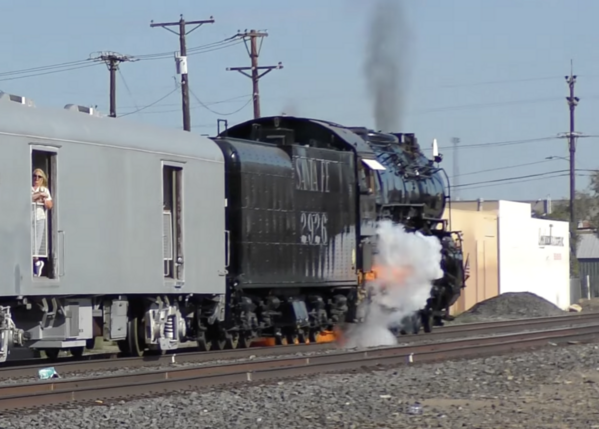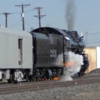Saw a video of it finally getting on a main line and it had what to me looked like a large back blast or something happen in the firebox. Had a good thump to it. Black smoke also started out of the smoke stack immediately. 
Replies sorted oldest to newest
Link to the video, incident occurs at 12:21 mark:
Just my opinion but, I don't believe any of their crew has much hands-on experience firing a large oil burning steam locomotive. That could have been just a brief loss of the flame, and subsequent re-ignition off the hot firebrick. Not really a big deal, but probably quite a surprise to those folks in the cab.
Nice to see. It's amazing they got this engine running after all the years of work (and money) put into it. Quite an achievement, and a great deal of devotion. Obviously an enormous undertaking to get such a massive steam engine operational. Many thought this would turn out to be just a pipe dream. I saw 2912 (located at Pueblo, Colorado) a number of years ago. It's just striking to see in person how huge these 2900 class engines are.
@breezinup posted:It's just striking to see in person how huge these 2900 class engines are.
Somebody once remarked. "That engine is so big it ought to have its own zip code."
Actually, there are larger engines. But that enormous, squared off, tender coupled with the very large 4-8-4, does give an awesome impression of "huge".
Interesting observation, Tom. You’re probably right - something about the particular symmetry of the combination of that tender and engine. No doubt the tender is a big contributor. I’ve seen the 844 FEF, the Challenger and the Big Boy, but for some reason standing next to a 2900 class just gave a real impression of enormity.
@Number 90 posted:Somebody once remarked. "That engine is so big it ought to have its own zip code."
Actually, there are larger engines. But that enormous, squared off, tender coupled with the very large 4-8-4, does give an awesome impression of "huge".
Besides the size of the locomotive and tender the drivers play a huge roll in the impressive "huge" feeling of a 2900, or most later (FEF, GS4) 4-8-4s. 80" drivers tower over an average person, which can make a 2900 feel more imposing than a Big Boy.
Very entertaining. It might have been interesting to have seen what went on inside the cab after that moment. ![]()
Yeah, those ATSF 4-8-4s are pretty big. I have a photo of me standing next to #3759 in Kingman, AZ. I'm a bit more than 5' tall, so the 80" (6', 8") wheels are quite a bit taller than me. By the way, the 2900-Class 4-8-4s on the Santa Fe were the heaviest Northerns ever built. I've also seen the UP FEF in Ogden, Utah. Man, that's a massive engine. The smoke deflectors make her seem way bigger, as well as the 80" drivers and her enormous tender, too.
Do they have agreements to run excursions on part of the line owned by New Mexico? But, isn't that the main BNSF line from Chicago to LA which is very busy with doublestack traffic? Or, does BNSF have an alternate route for freight?
@Robert K posted:Do they have agreements to run excursions on part of the line owned by New Mexico? But, isn't that the main BNSF line from Chicago to LA which is very busy with doublestack traffic? Or, does BNSF have an alternate route for freight?
To answer your question . . .
- Santa Fe had two routes between eastern Kansas and New Mexico, called Northern Route (via Dodge City, La Junta and Albuquerque) and Southern Route (via Wichita, Amarillo, Clovis and Belen) in the public passenger timetables of the era. The Northern Route was used by most passenger trains, and, along with the San Francisco Chief and a section of the Fast Mail & Express, freight primarily went via the Southern Route. It's the Southern Route that is part of what is known today as "the BNSF Transcon."
- BNSF stopped using the Northern Route for any freight because of two severe mountain grade sections, one at Raton Pass, and the other at Glorieta, as well as the existence of almost no on-line freight customers. The only regular traffic between La Junta, Colorado and Dalies, New Mexico is Amtrak's Southwest Chief and (between Belen and a point east of Albuquerque) the New Mexico RailRunner that goes to Santa Fe.
- BNSF seriously considered abandoning the Northern Route between La Junta and Albuquerque. New Mexico did not want the Amtrak service discontinued, so it now owns the former Santa Fe main line between Belen and (I think) the NM/Colorado state line on Raton Pass.
- The steam group would love to run the engine on state owned track, and there is no interference with freight traffic. However, there is a lot involved in obtaining rights and actually running trains. I understand that some sort of an agreement has been made with the state, to run excursions Albuquerque-Lamy, but can't say whether that is a simple willingness to discuss the possibility of steam trips, or a handshake, or a contract. Nonetheless, much more will be required if there is ever to be any operation of 2926 on the main line. We'll just have to patiently await any action and not get our hopes too high. The route between Albuquerque and Lamy would include some 90 MPH track, but would wye the engine at Lamy, and would not run on the mountain territory or the section which has a few remaining semaphores.
@Hot Water posted:Just my opinion but, I don't believe any of their crew has much hands-on experience firing a large oil burning steam locomotive. That could have been just a brief loss of the flame, and subsequent re-ignition off the hot firebrick. Not really a big deal, but probably quite a surprise to those folks in the cab.
From one of the responses in the comment section in the video RickO posted.
"For those wondering at 12:20 the fireman was relighting his fire. If the fire goes out on an oil burner (which can happen for a number of reasons) then the fuel is increased to attempt to relight off of the heat from the bricks. It isn't uncommon but it is definitely not an ideal scenario: the increase in unburnt fuel and gas becomes a hazard if it doesn't catch quickly. That was a pretty subtantial flash but I wouldn't really fault the crew here, given this is the first time on the road for 2926. Stuff happens"
@Number 90 posted:To answer your question . . .
- Santa Fe had two routes between eastern Kansas and New Mexico, called Northern Route (via Dodge City, La Junta and Albuquerque) and Southern Route (via Wichita, Amarillo, Clovis and Belen) in the public passenger timetables of the era. The Northern Route was used by most passenger trains, and, along with the San Francisco Chief and a section of the Fast Mail & Express, freight primarily went via the Southern Route. It's the Southern Route that is part of what is known today as "the BNSF Transcon."
- BNSF stopped using the Northern Route for any freight because of two severe mountain grade sections, one at Raton Pass, and the other at Glorieta, as well as the existence of almost no on-line freight customers. The only regular traffic between La Junta, Colorado and Dalies, New Mexico is Amtrak's Southwest Chief and (between Belen and a point east of Albuquerque) the New Mexico RailRunner that goes to Santa Fe.
- BNSF seriously considered abandoning the Northern Route between La Junta and Albuquerque. New Mexico did not want the Amtrak service discontinued, so it now owns the former Santa Fe main line between Belen and (I think) the NM/Colorado state line on Raton Pass.
- The steam group would love to run the engine on state owned track, and there is no interference with freight traffic. However, there is a lot involved in obtaining rights and actually running trains. I understand that some sort of an agreement has been made with the state, to run excursions Albuquerque-Lamy, but can't say whether that is a simple willingness to discuss the possibility of steam trips, or a handshake, or a contract. Nonetheless, much more will be required if there is ever to be any operation of 2926 on the main line. We'll just have to patiently await any action and not get our hopes too high. The route between Albuquerque and Lamy would include some 90 MPH track, but would wye the engine at Lamy, and would not run on the mountain territory or the section which has a few remaining semaphores.
Just a few corrections. New Mexico bought the line as far north (east) as Lamy. BNSF still owns the track between there and La Junta.
The semaphores are either gone or about to be gone. There are no parts supplies left for them. They are in the process of being replaced by the ubiquitous Darth Vaders.





